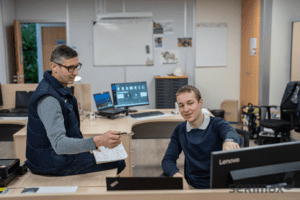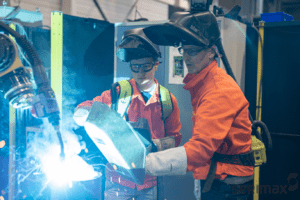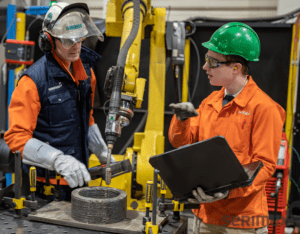Wire Arc Additive Manufacturing

The team we are talking to today consists of Guillaume Bruez and Sylvain Loriot; they manage Additive Manufacturing at Serimax and are also part of Olivier Revel’s team.
Sylvain (on the left of the photo), Guillaume (on the right): tell us about their work-experience…
Guillaume after completing his preparatory class in Physics Technology and Engineering Science, achieved his general engineering studies at the Ecole Nationale Supérieure d’Arts et Métiers in Metz. He then went on to specialize in Welding in his final year at the Ecole Supérieure de Soudage et de ses Application at the Institut de Soudure and was hired by Serimax in R&D department.
Sylvain arrived at Serimax after the 1998 World cup and started as a welder; since then, he has travelled all around the world, working on some of the world’s biggest projects and has acquired a wealth of experience. Working alongside the engineers Sylvain fine tunes the arc to find the best operational configuration (repair rate, productivity) having completed many projects in this way; the team knows that this is efficient for successful operations.
Their main task is to develop new welding strategies, validate welding consumables and optimize welding parameters on projects supervised by Vallourec (through Vallourec Additive Manufacturing solutions).
What is Wire Arc Additive Manufacturing?
WAAM is an additive manufacturing process which is part of the Direct Energy Deposition family. This is a manufacturing process consisting of welding deposition applied on the previous layer, to obtain a near net shape part. Today, Gas Metal Arc Welding process is used by Serimax for this application, using different synergies.


What are the main advantages of using this technology?
Even if the cost of this solution can often appear to be more expensive than traditional processes like forging or casting to obtain a raw part, its flexibility is incredible, providing us with:
- Faster solutions to produce any one single part, without heavy industrial facilities.
- Reducing material waste by manufacturing raw parts as close as possible to the final shape and applying expensive materials only were useful.
- Reducing the storage of parts, meaning that we only have to build the required parts when needed.
- Building different complex sized parts with optimized designs which may not be possible with conventional processes.
What is the hardest thing about additive manufacturing and welding?


WAAM appears to be more complex than welding, because of the metallurgy of the deposition, but also its 3-dimensional shape needs to be controlled at the same time. Welding parameters, trajectories and temperatures are the key focal points of the process. Moreover, welding needs to be applied without side support, and then the welding pool must be maintained to reach the required shape. Then welding parameter optimization is required to manage the wettability and to achieve the right deposition by improving the deposition rate and limiting the defects. Trajectories enable the welding bead to be applied to a precise position and to obtain a clean deposition. Distortion must also be considered in the trajectory repartition to assure that the final part is acceptable. Regarding the long arc time duration, temperature rapidly rises, and then needs to be controlled to assure the mechanical properties, the right isotropy of the part and limit the application of a Post Weld Heat Treatment